The red and white color combination is one of the favorite color combinations of the majority of people. If I were to tell you that red and white animals also exist, you would undoubtedly be amazed. They are unique yet attractive. I compiled a list of 14 such red and white animals that exist in nature. So let’s start this article without delay.
List Of 14 Red and White Animals
1. Phantasmal Poison Frog
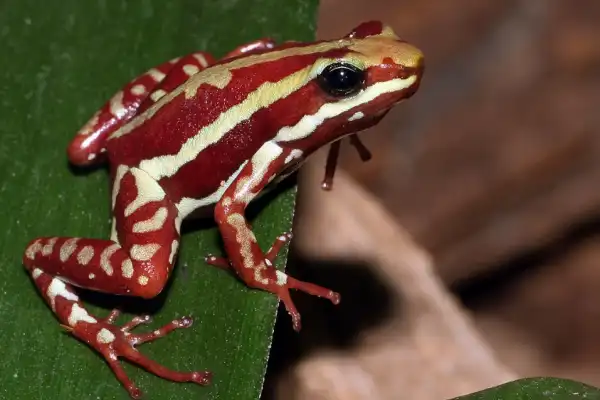
- Scientific name: Epipedobates tricolor
- Size: 22.6 mm (0.9 in)
- Geographical Location: Central Ecuador in Bolívar Province
- Diet: poisonous ants and insects
This Ecuadorian endemic frog is known by a lot of common names, like phantasmal poison frog or phantasmal poison-arrow frog.
They are red in color with white strips with a hint of yellow hue. They are highly toxic, as their diet mainly consists of poisonous ants and insects.
These vulnerable species inhabit tropical and subtropical rainforests. Pharmaceutical firms exploit their secretions to make medicines, such as epibatidine.
2. Discus Fish
- Scientific name: Symphysodon discus
- Size: 20 centimeters (7.9 in)
- Geographical Location: Amazon Basin
- Diet: Small worms, crustaceans, plant matter, insects, and detritus
Red discus or Heckel discus are some of the common names of Symphysodon discus.
They can be seen adding to the allure of freshwater aquariums.
As you saw in this picture, it is red in color with white intricate patterns all over the body.
They are commonly found in the Amazon basin, inhabiting blackwater with a high temperature of 79–90 °F and a low pH of 4.2–5.2.
3. Red Milk Snake
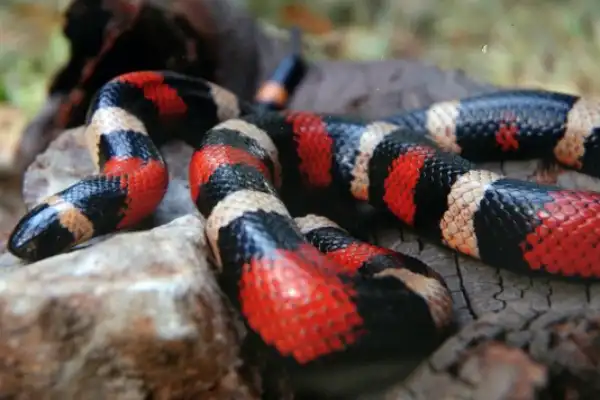
- Scientific name: Lampropeltis triangulum syspila
- Size: 24–36 inches
- Geographical Location: southern Indiana through northwestern Mississippi, western Kentucky, southeastern South Dakota, and into eastern Oklahoma and Kansas
- Diet: Small rodents and lizards
The red body with white bands is the characteristic feature of the red milk snake. Rather than biting their victim, these non-venomous snakes consume them straight after squeezing them till they pass away.
Their diet is mainly composed of small rodents and reptiles like lizards.
People often mistake them for coral snakes It’s a common misconception that they’re coral snakes, which helps them avoid human contact.
When they feel threatened, they strike at the predator to bite, but instead of biting, they produce a foul odor, that drives the animal away.
4. Red-cap Oranda
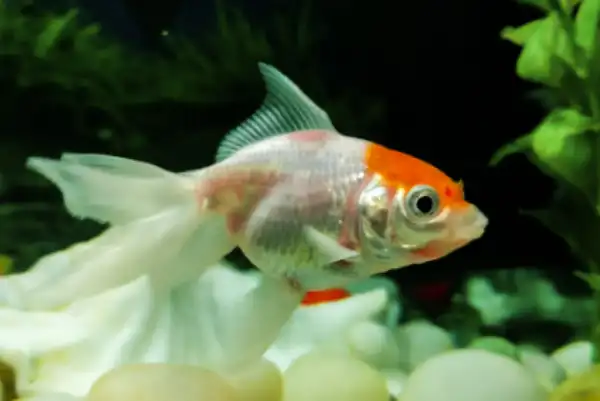
- Scientific name: Auratus auratus
- Size: up to 7 inches
- Geographical Location: China and Japan
- Diet: rine shrimp, blood worms, Daphnia, or tubifex worms
Look at the picture and see how mesmerizing they are. Meet the Red cap Oranda, which looks like that white fish is wearing a red cap, known as a wen.
They are very famous among fish keepers because of their striking coloration and shiny white scales on their bodies, which increase the beauty of aquariums by many folds.
5. Red Panda
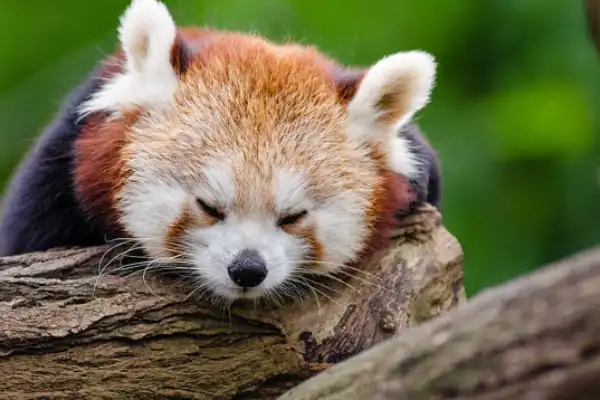
- Scientific name: Ailurus fulgens
- Size: 51–63.5 cm (20.1–25.0 in)
- Geographical Location: Nepal, India, Bhutan, Myanmar and China
- Diet: Bamboo shoots, leaves and fruits
As implied by their name, red pandas have black undersides and are reddish-brown in appearance. There are additional white spots on the brows, cheeks, muzzle, and other areas.
They are not as big as giant pandas. Their height is similar to that of raccoons and they can attain a length of 51 to 63.5 cm (20.1-25.0 in).
Their mother-child bond is identical to that of cats. These lazy creatures spend their 2/3 of the day sleeping around.
Some research has proved that their white portion is kind of luminescent, and this property is used by mother pandas to find their babies.
6. Red and white giant flying squirrel
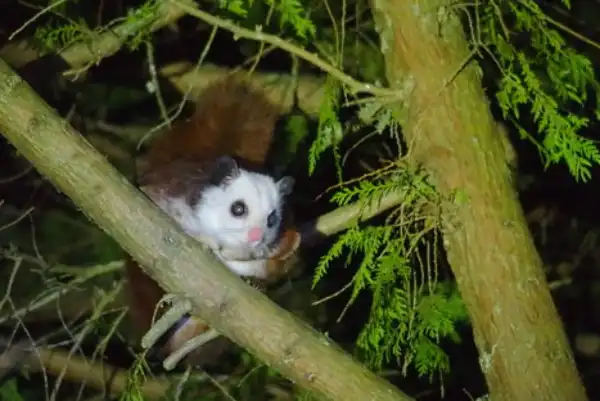
- Scientific name: Petaurista alborufus
- Size: 35–58 cm (14–23 in)
- Geographical Location: central and southern China and Taiwan
- Diet: Nuts, fruits, leafy vegetation, insects and their larvae
This red and white squirrel is a common sight in central and southern China and Taiwan.
There is always a misconception about flying squirrels that they fly, but in reality, they glide using patagium, which is the furry membrane that is present between their limbs.
Just take a look at their faces—with that white face and the reddish-brown fur covering their body, they appear so innocent.
They are as long as 3 feet, which makes them the largest among flying squirrels.
7. Red cotton stainer bug
- Scientific name: Dysdercus suturellus
- Size: 3/5 inch
- Geographical Location: Southern Florida, Cuba and Jamaica
- Diet: Nectar
The red abdomen with white horizontal stripes makes this insect fascinating.
When you look from above, their wings are brown in color with a large cross-shaped pattern.
Their common name, Red Cotton Stainer Bug, clearly indicates that they stain the cotton by feeding on those walls and leading to the growth of fungus that appears like a stain.
They have a great affection for citrus blossom nectar.
8. Red and White Wartskin Anglerfish
- Scientific name: Antennarius maculatus
- Size: up to 15 cm
- Geographical Location: Indo-Pacific area
- Diet: small animals, mainly fishes
Look at this fish; it looks interesting, doesn’t it? This fish is found in the Indo-Pacific area in many color-morph forms.
However, the red and white wart skin anglerfish is the morph we will talk about today.
They have a spiky look due to the tiny spicules covering their bodies.
Depending on their surroundings, they change their body color, which helps them in camouflaging.
Their eggs are covered with a mucus membrane called an egg raft.
9. White Jersey Giant Chicken
- Scientific name: Gallus gallus domesticus
- Size: 1.5 to 2 feet
- Geographical Location: Burlington County, New Jersey
- Diet: seeds, plants, insects, earthworms, snails, small animals
The white-jersey giant chicken is one of the largest chicken breeds of the American class and originated in New Jersey.
The main motive for making this breed is its high meat production. but apart from that, they are also capable of laying 240 extra-large eggs in a year.
They differ a lot from the Jersey Giants in appearance. They are pure white in color with a characteristic red hood.
10. Red fox
- Scientific name: Vulpes vulpes
- Size: 76.7–105.3 cm
- Geographical Location: Europe, temperate Asia, northern Africa, and North America
- Diet: small rodents, squirrels, woodchucks, rabbits, birds and eggs, amphibians, reptiles, vegetation and fruits
There are a lot of color morphs of red foxes present in Europe, temperate Asia, northern Africa, and North America.
A typical red fox is characterized by its reddish fur, black-tipped ears or feet, and white-tipped tails.
These red foxes with white underparts are the largest among all the fox species that exist in this world, with a length of 76.7 to 105.3 cm.
They have a special ability to sense ultrasonic radiation, which is the maximum in all mammals.
Apart from cleverness, they are also athletic and can even jump as long as 6 feet, which helps them a lot in hunting.
11. Albino cardinal
- Scientific name: Cardinalis cardinalis
- Size: 20.9 to 23.5 cm
- Geographical Location: southeastern Canada
- Diet: insects, seeds, grass, leaf buds, flowers, berries, etc.
After hearing about the northern cardinals, what’s on your mind? A red-colored bird with a dark red beak right. But in this article, we are going to see about their modified form, i.e., Albino cardinal.
Due to genetic variation, scarcity of melanin occurs, which leads to their unique coloration.
Due to low melanin concentration, their eyesight also becomes weak, which affects their survival rate.
You can easily identify them by their unique pink coloration, white elegant feathers, and red crown. The vivid pink eyes of these Canadian birds astonish you.
12. Red-capped robin
- Scientific name: Petroica goodenovii
- Size: 10.5–12.5 cm (4.1–4.9 in)
- Geographical Location: Australia
- Diet: Insects and other small arthropods
Just give it a minute and observe this beauty of nature. It looks ethereal, isn’t it? They are known for their striking dark red coloration with black underparts and white plumage underwings.
They aren’t as playful as they appear; they are very aggressive and can violently attack when they feel threatened.
Spiritually, they are considered the symbols of good luck, happiness, and rebirth. This Australian native feeds on insects and other small arthropods.
13. Yellow-billed Cardinal
- Scientific name: Paroaria capitata
- Size: up to 16·5 cm
- Geographical Location: Brazil, Paraguay, Bolivia, Hawaii, Uruguay, and northern Argentina
- Diet: seeds and insects
Now we have another cardinal bird species on our list of 14 red and white animals. The yellow-billed cardinal is known for its yellow bill, redhead, black upper parts, white underparts, and black chin.
One can find them in Brazil, Paraguay, Bolivia, Hawaii, Uruguay, and northern Argentina, inhabiting forested marshes, flooded fields, riparian scrub and forest, and wooded lakeshores.
Males usually fluff up their feathers, puff out their chests, and sing intricate songs in order to attract females.
14. Red Munia
- Scientific name: Amandava amandava
- Size: 9·5–10 cm
- Geographical Location: Tropical Asia
- Diet: mainly grass seeds
Amandava amandava, commonly known as Red Munia, Red avadavat, or Strawberry Finch, is found in tropical Asia.
As you can see in the picture, they are bright red in color with brown wings. White specklings on their whole body make them look enchanting.
Females of red munia choose males with a brighter coloration to mate with.
Their diet consists mainly of grass seeds and insects such as termites.
Our discussion of red and white creatures, which are not only exquisite but also significant to the ecosystem, comes to an end here. Because predators interpret this coloring as a warning of impending danger, animals with this coloring also have a higher survival rate. I will thus be posting another piece shortly. Enjoy reading them till then.

Being a zoology student I’m always been fascinated toward animals especially insects. I love to do research and learn about different animals. As a writer I want to share my thoughts about nature through my articles. Apart from this you can find me exploring the new places and voice notes.
